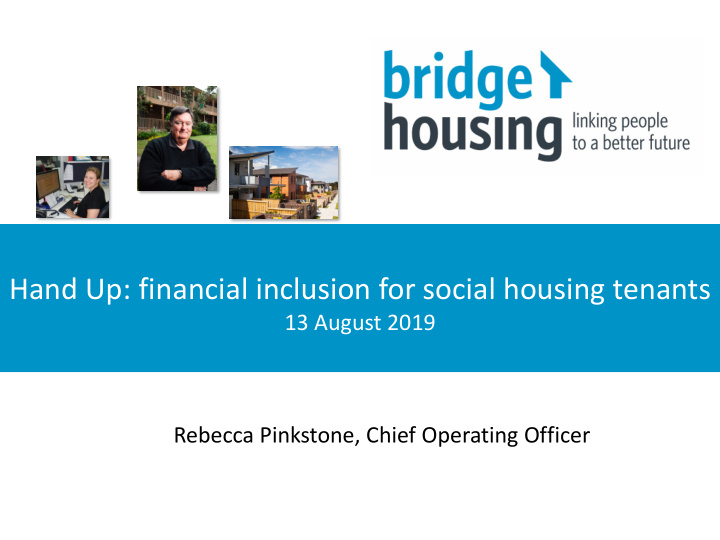



Hand Up: financial inclusion for social housing tenants 13 August 2019 Rebecca Pinkstone, Chief Operating Officer
Who we are 3,500 properties 90 staff 4200+ residents 63% tenants are single 60% head tenants are 9% Aboriginal tenants person women 20 Local Government Areas – traditional inner city $40m million bank debt base – focus on homelessness facility through NHFIC 65% increase in property portfolio as a result of the Social Housing Management Transfer (1,200 new properties in Sydney’s Northern Beaches added to portfolio) 2
3
Our tenants • Low income households – 88% Centrelink – 12% wages • Low eviction rate • Low arrears • Most tenants have no arrears – Tenants generally good money managers – Proactive housing management for those in need 4
Hand Up – arrears management • Who? Significant arrears and at risk of losing their tenancy – Experiencing acute economic hardship and other risk factors – • What? Tenants work off debt through activities that address underlying issues – • How? All participants undertake financial counselling and enter debt repayment plan – A support partner works with participants to prepare a schedule of activities based on – their needs Arrears written off as activities are completed – 43 referrals 5 current $1128 av debt since 2016 participants written off p/p 5
Hand Up – real stories “I know now how to be happy and “The most significant impact do good things for myself” of the Hand Up Agreement has been being able to get debt cleared and do it through doing something useful for me “Knowing that Bridge Housing – financially, emotionally, and thinks I’m worth investing in – in terms of education.” worth working on… it made me think I’m worth working on myself. So I am, for the first time in I don’t “I’ve established a record of know how long.” meeting obligations.” 6
Bridge to Work – employment • Who? – Working age tenants who are not working, or not in secure work • What? – Tenants receive one-on-one support to find a job or training/education opportunities that support employment • How? – Bridge Housing has partnered with CoAct to deliver the program 111 referrals 33 placements 75 ongoing participants 18 placements 13+ weeks 7
Bridge to Work – case studies “There was a lot of “Just having someone there to understanding. I felt reassured support you. [My job search and I was being helped. With agency] doesn’t do a lot to other organisations, like help me. Gavin covers a lot. Centrelink, it comes across as a It’s more personal, one-on- punitive system. They want you one. That makes me feel more to get out of there. You have to than just a number, like he get a job doing anything even really wants to help me get a though you are not interested job that I want.” in it.” 8
Start Work Incentive • Who? – Tenants who have recently started working after being out of work for at least 12 months • What? – Rent freeze of up to 26 weeks, before rent is re-calculated to include income from wages • How? – Tenants contact Bridge within 21 days of starting work 23 households involved 9
Recommend
More recommend